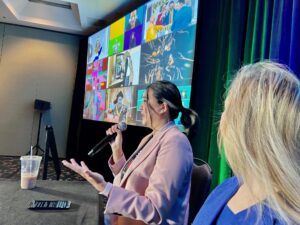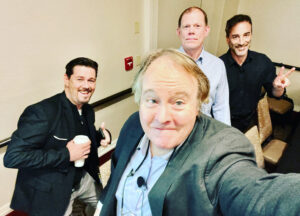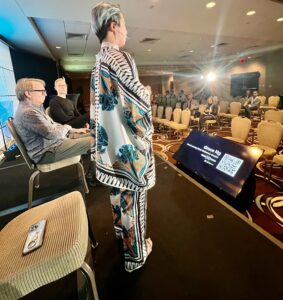Chris Pfaff moderated an all-star panel on the FAST industry sector – ‘FAST Times: Keeping Up with the FAST Ecosystem’ – during the virtual Streaming Media Connect conference, on August 24, 2023, with Christina Chung, from Estrella Media; Damian Pelliccione, from Revry; Marisa Elizondo, from Fubo, and Jeff Flanagan, from HARTBEAT.

You can watch the entire session at: https://www.youtube.com/watch?v=ZglJiD-iy5A
Read Steve Nathans-Kelly’s piece on the session in Streaming Media, dated November 7, 2023 and Tyler Nesler’s piece from September 15, 2023 below:
The State of FAST: Around the Horn with Fubo, Estrella Media, and HARTBEAT
With all the talk of FAST 2.0 and the explosion of FAST channels to the point of approaching market saturation, is FAST’s self-reinvention a foregone conclusion, or even advisable at this juncture? What are the new and emerging FAST growth strategies that are driving growth today, as opposed to a year or two ago? And how have the strikes in Hollywood that consumed at least 2 quarters of the year impacted channel and content development? At Streaming Media Connect 2023, Chris Pfaff of Chris Pfaff Tech Media posed these questions to three executives from key players in the FAST ecosystem: HARTBEAT, Fubo, and Estrella Media.
For Kevin Hart-founded entertainment network HARTBEAT (formerly known as Laugh Out Loud), the emerging FAST strategy has been surprisingly YouTube-focused. “We’re seeing more growth in viewership minutes and numbers, but with the caveat that where we’re seeing that growth is on the big ones–Tubi, Pluto, Samsung, Roku,” says Jeff Clanagan, President and Chief Distribution Officer at HARTBEAT. “We just launched a FAST channel on our YouTube page, which is doing extremely well. We’ve only been up about four months now. The advantage that we had in doing that is we already had a YouTube page that had five million subscribers on it. So what we were able to do–which I think only a couple of people have done– is launch our FAST stream on our YouTube page versus a separate FAST stream in another environment in YouTube. So we are able to tap into that audience that we’ve already curated.”
For sports-centric live TV streaming network Fubo, the strategy of leaning heavily into FAST with new channel launches has continued apace despite the writers and actors strikes that have largely halted the production or infusion of new content. “Fubo is a live streaming platform,” says Fubo VP, Content Strategy & Acquisition Marisa Elizondo. “We’re sports-focused. We’ve leaned in very heavily over the past year into the FAST space thinking, ‘There is probably a happy medium between the FAST world and the traditional linear networks. So over the past year, we were taking a slow and steady approach to launching FAST channels, and we actually leaned in quite heavily and launched about 100 FAST channels. And what’s unique about us is that we’ve mixed them in between all of the packaging. So if you pulled up our channel lineup, you would see that all of the FAST channels are kind of mixed in. And it’s been great. Despite the strikes, we have still had a ton of inbound requests of new networks that are trying to get launched, trying to get eyeballs. So I’m rather busy in taking all of those, but I don’t think the strikes have deterred any independent nets or new nets from trying to get additional distribution.”
“FAST has grown significantly,” said Christina Chung, VP Business Operations at Spanish-language multi-platform media company Estrella Media. “In the last three years, our business at Estrella has really grown from FAST distribution at $0 to a multi-million-dollar business. We work with a number of different partners such as Fubo where we have our four channels: Estrella TV, Estrella News, Estrella Games, and Cine Estrella, which is our movie channel. And we’ve seen astronomical growth because I think viewers in the world are looking for places where they can find content outside of just buying a cable subscription or a broadcast subscription. So it is an opportunity to have a free ad-supported television experience that is very similar to the traditional linear business. And Estrella has put all of our marketing dollars into FAST and do have our own app, but FAST is our bread and butter at this point. It’s grown into this behemoth where we work very closely with all of our different distribution partners and we work on different content strategies with each of them.”
How Premium Brands Are Leveraging FAST
by Tyler Nesler, Streaming Media
September 15, 2023
As with any other entertainment streaming genre, the engine driving FAST is the monetization of content, and as with large-scale live events in particular, FAST thrives on pairing brands with properties and serving those brands effectively. In this clip from Streaming Media Connect 2023, Chris Pfaff, CEO, Chris Pfaff Tech Media, Producers Guild of America (PGA), VR AR Association (VRARA), talks with Damian Pelliccione, CEO / Co-Founder, Revry, how Revry works with brands and the sort of brand identification with key Revry programming that enables the industry’s leading LGBTQ+ programming destination to thrive and grow.
“There’s more innovation happening every day in FAST,” Pfaff says. “Damian, what’s interesting is a lot of people think, ‘I’ve heard of these guys Revry and what they’re doing. They’ve got these brands, they’re FAST. This isn’t subscription, this isn’t even AVOD. How do you do that? Are [people] coming to you saying, ‘I see something really both subversive and also very clever in that strategy of pulling people in who have disposable income, brands who want to attach themselves because there’s an audience, not because they just like throwing cash around. Do you find other people who are looking to pay you flattery by imitation, or where is that going?”
“I think the biggest thing we did is we built distribution and we built audience,” Pelliccione says. “We’re over 5 million monthly active viewers across all of our apps and channels, with almost 80% of that coming exclusively from our FAST channel partners. And we’ve leveraged the opportunity to sell that inventory at really high CPMs. We’re selling at the height, during Pride season, at 50, 60 CPMs, the entry point being 35, because we’re a very affluent market. We have the [highest] amount of scale of video inventory in CTV addressing this market, and we’ve not been challenged. We’re really the thought leader in this space.”
Pelliccione emphasizes that the core of FAST effectiveness is having great and original content. “Obviously, that takes the cake, where our original programming is completely underwritten by brands, de-risking all of the opportunity, us owning all of that IP,” they say. “We did over 1.5 million views in two weeks for a Voguecompetition show that was completely underwritten by Henkel’s got2b brand, the hair gel and dye, which I’m wearing right now, and Nike, which I’m also wearing right now. I obviously like to support all the brands that support us. And a shout out to John Lear, Mark [Bracero], and Linda [Morel] at Triple Threat Productions. We’re seeing multi-Emmy award-winning producers. Mark has five Emmys for Queer Eye. He’s nominated currently. Linda, having won for Key & Peele, is currently nominated for A Black Lady Sketch Show. Producers from traditional media are trying to get into the FAST and the AVOD market and work with networks like Revry because they see us scaling our business, scaling our original content opportunity, working with brands, and creating. We only create unscripted content from an original standpoint, and seeing [opportunities] like Drag Latina, which Triple Threat is producing for us right now. We did a million live impressions when we announced that show [and] when we actually premiered season one last fall, and they’re producing season two right now as we speak in Los Angeles.”


























